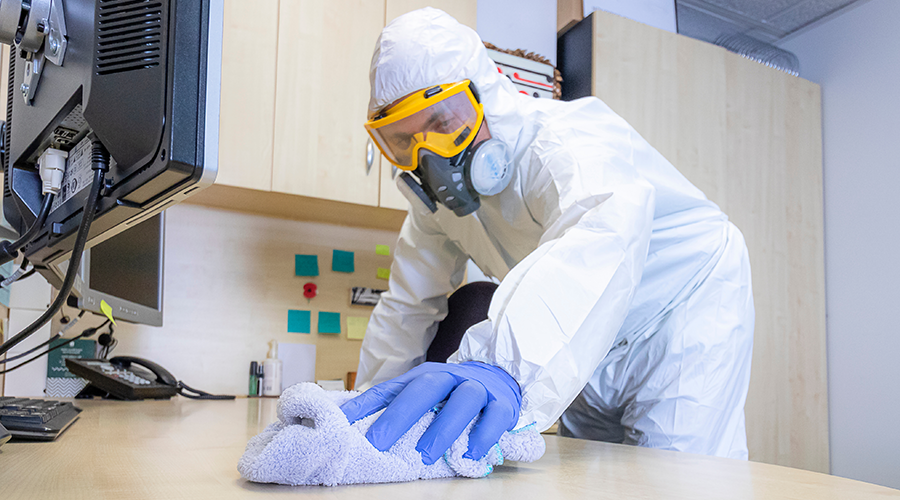While presenting a seminar about the importance of proper cleaning and disinfection in preventing hospital acquired infections, I said, “Using elbow grease is such an important first step in order to achieve disinfection.”
A young woman in the back of the room raised her hand with a question: “Where can I buy that elbow grease? I’ve never heard of it before.”
I suppressed a smile and explained, “Elbow grease is the hard physical work that's often required to get the difficult task of cleaning done. You can’t just spray and wipe. You need to apply chemicals with a vigorous intent to remove whatever is dried on that surface.”
The fact is, washing or scrubbing a surface while applying 1-2 pounds of pressure will physically remove soil and organic material such as blood and body fluids while taking many pathogens with it. High-tech solutions and plenty of elbow grease are needed in the intensified fight against surface contamination.
Staphylococcus aureus is a well-known nosocomial pathogen with its ability to survive in the hospital environment for several days. The ability of S. aureus and Methicillin-resistant Staph Aureus (MRSA) to form biofilm on high-touch surfaces prolongs their survival and spread. Studies have proven that MRSA produces biofilm on surfaces, making it difficult to remove with a spray-and-wipe motion. This trait is alarming because MRSA isolates imbedded in biofilm can survive long duration and become a potential source of MRSA-associated infections. The surgical department is one place where elbow grease is critical in providing a safe environment for surgical cases.
Monitoring compliance
Victoria Hornbeck, RN, BSN, CNOR, was put in charge of reimagining the between-case cleaning of orthopedic operating rooms at Northside Hospital Forsyth in Cumming, Ga., and used adenosine triphosphate (ATP) testing of high-touch surfaces to identify gaps in the process.
The gap she discovered in the hospital’s cleaning protocol had nothing to do with allowing enough time for surface disinfectants to dry. It didn’t involve staff forgetting to clean certain surfaces. Believe it or not, the gap involved the amount of elbow grease staff applied while wiping down rooms between cases.
“The testing of high-touch surfaces revealed staff had to go over some areas two or three times to get them clean,” says Hornbeck, the hospital’s quality improvement and nurse clinician of surgical services. “They don’t often think about how much friction they’re applying during cleaning. That’s certainly not something we would have considered without the testing.”
ATP is the molecule cells use to survive. Its presence indicates microbial activity and shows the tested surface had not been decontaminated. Hornbeck used the evidence-based threshold of 100 RLUs to determine the cleanliness of operating room surfaces. Areas exceeding that threshold were recleaned with ample elbow grease and retested until a clean reading was achieved.
The most stringent hand hygiene program and an expensive terminal disinfecting device are no match for poor cleaning practices. Elbow grease and the right products and tools are essential to ensure healthcare facilities remain as pathogen-free as possible.
J. Darrel Hicks, BA, MESRE, CHESP, Certificate of Mastery in Infection Prevention, is the past president of the Healthcare Surfaces Institute. Hicks is nationally recognized as a subject matter expert in infection prevention and control as it relates to cleaning. He is the owner and principal of Safe, Clean and Disinfected. His enterprise specializes in B2B consulting, webinar presentations, seminars and facility consulting services related to cleaning and disinfection. He can be reached at darrel@darrelhicks.com, or learn more at www.darrelhicks.com.

 Hand, Foot and Mouth Disease on the Rise
Hand, Foot and Mouth Disease on the Rise Preparing for the Hazards of Winter Weather
Preparing for the Hazards of Winter Weather BayCare Reveals Pagidipati Children's Hospital at St. Joseph's
BayCare Reveals Pagidipati Children's Hospital at St. Joseph's Why Identity Governance Is Becoming a Facilities Management Issue
Why Identity Governance Is Becoming a Facilities Management Issue Habitat Health Opens South Los Angeles PACE Center
Habitat Health Opens South Los Angeles PACE Center